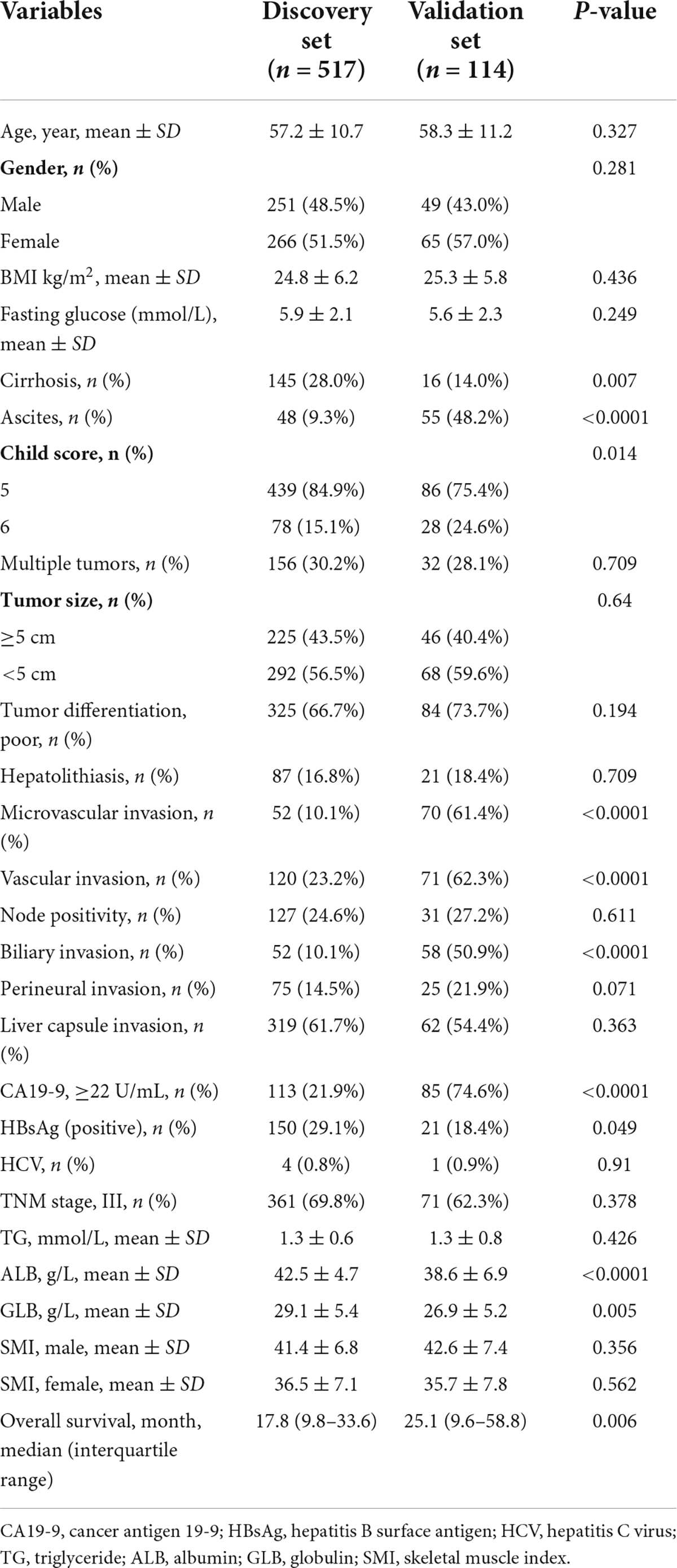- 1State Key Laboratory of Biotherapy and Cancer Center, Department of Liver Surgery and Liver Transplantation, West China Hospital, Sichuan University and Collaborative Innovation Center of Biotherapy, Chengdu, China
- 2Department of Hepatobiliary Surgery and Liver Transplantation, The First Affiliated Hospital of Chongqing Medical University, Chongqing, China
Background: High serum triglyceride (STG) level is a well-established pathogenic factor for cardiovascular diseases and is associated with the risk of various malignancies. Nevertheless, the role of STG level in intrahepatic cholangiocarcinoma (ICC) remains uncertain.
Methods: A total of 631 ICC patients treated with curative hepatectomy in two centers (517 in the discovery set and 114 in the validation set) were retrospectively analyzed. Kaplan–Meier survival analysis was used to assess the outcomes of the patients with different STG levels. Time-dependent receiver operating characteristic (ROC) analysis was conducted to compare the prognostic value of STG with other established indexes. The Triglyceride-Albumin-Globulin (TAG) grade was introduced and evaluated using the time-dependent area under curves (AUC) analysis and decision curve analysis (DCA).
Results: Patients with increased STG levels and decreased albumin-globulin score (AGS) were correlated with improved overall survival (OS) and recurrence-free survival (RFS). STG level ≥ 1 mmol/L was an independent protective factor for surgically treated ICC patients. The predictive value of the TAG grade was superior to the STG or the AGS alone. In decision curve analysis, the net benefits of the TAG grade in the discovery and validation set were higher than STG and AGS.
Conclusion: The current study presented strong evidence that ICC patients with higher preoperative STG levels had preferred long-term surgical outcomes. The novel nutritional score based on serum triglyceride, albumin and globulin levels was inextricably linked to the prognosis of the surgically treated ICC patients. Evaluation of the TAG grade before curative hepatectomy may be beneficial for risk stratification and clinical decision support.
Introduction
Liver cancer remains the fifth leading cause of all-cause mortality and the second most common cause of cancer-related death in China (1, 2), which leads to 37 per 10000 people of newly diagnosed cases annually (2). ICC represents a major subtype of biliary tract cancer located within the liver parenchyma (3), accounting for nearly 20% of primary liver cancers (4), of which the incidence and mortality are increasing rapidly in recent years (5). ICC is often diagnosed at an advanced stage with limited treatment options available; surgical resection remains one of the major treatment modalities (6). Recurrence is frequent after liver resection, resulting in a poor prognosis with less than 40% of surgically treated ICC patients on survive more than 5 years (7). Therefore, prognostic indicators are required to evaluate the outcomes of the surgical candidates and carry out early interventions, thus improving postoperative survival.
The population with ALD and NAFLD in China increased sharply (8, 9), as a result, the incidence and mortality of liver cancer started to soar since 2015 after a short duration of decline in the first decade of the 21st century (10). Previous studies had demonstrated that the metabolic syndrome (obesity, dyslipidemia, hypertension, and impaired fasting glucose/diabetes mellitus) was associated with increased risk of ICC (odds ratio = 1.56, P < 0.0001), whereas treatment with metformin was significantly related to a reduction of ICC risk (11, 12). High STG level, as an essential component of metabolic syndrome, was positively associated with the risk of multiple malignancies (lung, rectal, thyroid, renal, and gynecological cancers) and was inversely associated with the risk of non-Hodgkin’s lymphoma and prostate cancer (13); however, the correlation between STG concentration and the prognosis of ICC patients have been inconclusive (14, 15).
As crucial components of human serum proteins, albumin (ALB) and globulin (GLB) levels were widely used in nutritional assessment. Previous studies have presented that elevated levels of serum ALB increased the risks of esophageal and cervical cancers (16, 17). GLBs, a group of proteins that binds estrogen, dihydrotestosterone and testosterone, play an essential role in the inflammatory immune response (18). Moreover, the high pretreatment ALB/GLB ratio has been proved to be associated with increased 5-year mortality and recurrence in different human cancers, including breast and gastric cancers (19). Similarly, another model based on serum ALB and GLB level, the AGS, has been applied in predicting the prognosis of non-small-cell lung cancer (20). As well, our recent study showed a positive correlation between the AGS and the long-term outcomes of ICC patients (21).
In the current study, we aimed to determine the correlation between STG and the long-term survival of surgically treated ICC patients. In addition, a novel nutritional score based on the STG concentration and the AGS (Triglyceride-Albumin-Globulin, TAG) was generated; we hoped to evaluate the clinical efficacy of the TAG grade in the prognosis of ICC patients after curative surgery.
Materials and methods
Study population
A total of 631 patients ICC patients received curative resection at two medical centers, West China Hospital of Sichuan University and the First Affiliated Hospital of Chongqing Medical University, were sequentially enrolled. 517 patients underwent surgery at the West China Hospital during December 2008 and December 2017 were included as discovery set, 114 patients underwent surgery at the First Affiliated Hospital of Chongqing Medical University between May 2010 and December 2015 were included as the validation set to verify the efficiency of the novel scoring system. The inclusion criteria were as follow: (1) histologically diagnosed ICC; (2) underwent liver resection with curative intent initially; (3) no lipid-lowering treatment within 2 weeks prior to the operation; (4) serum TG measured in fasting status; exclusion criteria: (1) patients underwent preoperative RFA, TACE, radiation treatment, targeted therapy, or other anti-cancer treatment; (2) extrahepatic metastasis before the operation; (3) positive resection margin; (4) ruptured tumor; (5) patients with incomplete clinical and histological data or lost to follow-up. Written informed consents were obtained from all participants or their entrusted agents. This study was approved by the ethics committee of West China Hospital of Sichuan University (Approval number: 20211506) and the First Affiliated Hospital of Chongqing Medical University (Approval number: 2021-288), following the guidelines of the 1975 Declaration of Helsinki.
Data collection and follow-up
All the clinical and histopathological data were accessed from the electronic medical record system. Preoperative information was collected as follows: platelet counts; bilirubin, albumin (ALB), and globulin (GLB) levels; triglyceride (TG), cholesterol (CHOL), and low-density lipoprotein (LDL-C), ALT, and AST levels; HBV and HCV viral loads; carbohydrate antigen 19-9 (CA19-9) level; furthermore, the height and weight of the patients were obtained to calculate the body mass index (BMI) as weight divided by height squared (kg/m2). The normal range of the TG was 0.29–1.83 mmol/L according to the determination kit’s instruction. The optimal cut-off values of the TG, CHOL and LDL-C were determined as 1, 3.8, and 2.6 mmol/L, respectively (Supplementary Figure 1). As we previously reported, the cut-off values of the ALB and GLB were 41.7 and 28.6 g/L, respectively (21); the AGS was characterized as following criteria: patients with both normal values of the ALB (>41.7 g/L) and GLB (≤28.6 g/L) were defined as AGS 0, patients with both decreased ALB level (≤41.7 g/L) and increased GLB level (>28.6 g/L) were defined as AGS 2, those with single abnormal value were defined as AGS 1. Fibrosis-4 index (FIB-4) was calculated by (22); albumin-bilirubin index (ALBI) was calculated from the following formula: (log10bilirubin(mol/L)×0.66)−(albumin(g/L)×0.085) (23). SMI was calculated as described in our previous study (21). The cut-off values were identified by using the X-tile software (24). Clinical and histological characteristics, including the presence of liver cirrhosis, ascites and hepatolithiasis, numbers and diameters of the tumor nodules, differentiation, lymph node positivity, microvascular invasion (MVI), vascular and perineural invasion, were also attained. MVI was defined as the presence of tumor cells in vessels or in vascular space lined by the epithelial cells under the microscope. Vascular invasion was defined as large vessels invasion identified by imaging modalities or gross examinations. Positivity of No. 16 lymph node was regarded as extrahepatic metastasis and radical resection was not considered. The tumor-node-metastasis (TNM) stages were classified conforming to the 8th American Joint Committee on Cancer (AJCC) Staging Manual (25). Patients who received curative resections were followed-up every month within 1 year, then every 3 months within the first 2 years, and then every half year thenceforth, serum tumor markers and imaging methods (contrast-enhanced ultrasound or CT scan) were used in the surveillance of tumor recurrence. The overall survival (OS) was calculated from the date of curative hepatectomy to the date of death or the last follow-up (for those alive). The recurrence-free survival (RFS) was calculated from the date of curative hepatectomy to the detection of recurrence or the date of the last follow-up (for those without tumor relapse).
Statistical analysis
The software of EmpowerStats1 and R2 (v4.0.5) was used for statistical analysis; data were presented as mean ± standard deviation (SD), median (interquartile range) or proportion. Comparison of categorical and continuous variables between groups was performed with Student’s t-test, Pearson’s x2 test and Analysis of variance (ANOVA). Non-parametric Mann–Whitney U test and Kruskal–Wallis test were used to analyze the data with the abnormal distribution. The ideal cut-off values of TG, CHOL, LDL-C, ALB, GLB, FIB-4, and ALBI were identified by using the software of X-tile3. The discriminatory ability of the indexes was assessed by the time-dependent area under receiver operating characteristic (AUROC) analysis via the “survivalROC” package in R. Comparison between ROC curves were performed by using DeLong’s test via the “pROC” package in R. Kaplan–Meier curves were depicted according to the optimal cut-off values, and their differences between groups were determined by comparing the cumulative survival of the included ICC patients using the log-rank test. Cox proportional hazards regression model was used to identify potential prognostic factors for OS and RFS; clinical and histological parameters with P < 0.2 in the univariate model were integrated into the multivariate model. Comparisons between the complex and straightforward models were conducted through decision curve analysis (DCA) via the “rmda” package in R. P < 0.05 was considered statistically significant.
Results
Baseline characteristics of the patients
Five hundred seventeen patients [251 (48.5%) male, mean (SD) age, 57.2 (10.7) years] in West China Hospital and 114 patients [49 (43.0%) male, mean (SD) age, 58.3 (11.2) years] in the First Affiliated Hospital of Chongqing Medical University were finally included into the discovery set and validation set, respectively. The BMI of the patients was lower in the discovery set (24.8 ± 6.2 kg/m2) than those in the validation set (25.3 ± 5.8 kg/m2). Liver cirrhosis was observed in 145 (28.0%) patients in the discovery set and 16 (14.0%) patients in the validation set. All patients were classified into Child-Pugh grade A, among which 439 (84.9%) patients in the discovery set and 86 (75.4%) patients in the validation set were Child-Pugh score 5. Multiple tumor nodules were detected in nearly 30% of the patients in both sets (156 (30.2%) in the discovery set and 32 (28.1%) in the validation set). Less than half of the patients in both sets were with tumor nodules greater than 5 cm (225 (43.5%) in the discovery set and 46 (40.4%) in the validation set). 87 (16.8%) of the patients in the discovery set and 21 (18.4%) of the patients in the validation set were with intrahepatic calculus. Positive lymph nodes were revealed in 127 (24.6%) patients in the discovery set and 31 (27.2%) patients in the validation set, respectively. The average TG levels were 1.3 ± 0.6 mmol/L in the discovery set and 1.3 ± 0.8 mmol/L in the validation set. The average ALB and GLB levels were slightly higher in the discovery set (ALB: 42.5 ± 4.7 g/L, GLB: 29.1 ± 5.4 g/L) than those in the validation set (ALB: 38.6 ± 6.9 g/L, GLB: 26.9 ± 5.2 g/L). Additionally, more than half of the patients [361 (69.8%) in the discovery set and 71 (62.3%) in the validation set] were stratified into TNM stage III. Patients’ characteristics at baseline were summarized in Table 1.
Serum triglyceride level was an independent protective factor for intrahepatic cholangiocarcinoma
Several preoperative indexes related to serum lipid levels (TG, CHOL, and LDL-C) were compared, among the three indexes, only the serum TG level presented the discriminative ability for surgically treated ICC patients (Supplementary Figure 1); likewise, the upper limit of normal (ULN, 1.83 mmol/L) of TG was evaluated, no significant difference in the OS and RFS between the patients with and without hyperlipidemia (Supplementary Figure 2).
Therefore, 1 mmol/L was determined as the optimal cut-off value for serum TG level; 312 patients were with higher TG levels (≥1 mmol/L) and 205 patients were with lower levels (<1 mmol/L) in the discovery set, the correlations of characteristics with the serum triglyceride levels in the discovery and validation sets were demonstrated in Table 2 and Supplementary Table 1, respectively. Kaplan–Meier analysis suggested that the patients with higher TG levels had better OS and RFS than those with lower TG levels (median OS: 27.1 months vs. 21.5 months) (Figures 1A,B), a similar difference was further found in the validation set (Figure 2A). Models represented the preoperative hepatic function including the FIB-4 and ALBI score were also calculated; the discriminative capability of these two models and TG level to 1-, 3-, and 5-year OS and RFS were compared by using ROC; the AUC of TG were superior to that of FIB-4 and ALBI (Supplementary Figure 3). Consistently, multivariate analyses using the Cox proportional hazard model revealed that increased serum TG level was an independent protective factor for both the OS and RFS (OS: Hazard ratio, 0.66, P = 0.0014; RFS: Hazard ratio, 0.69, P = 0.0012) (Table 3).
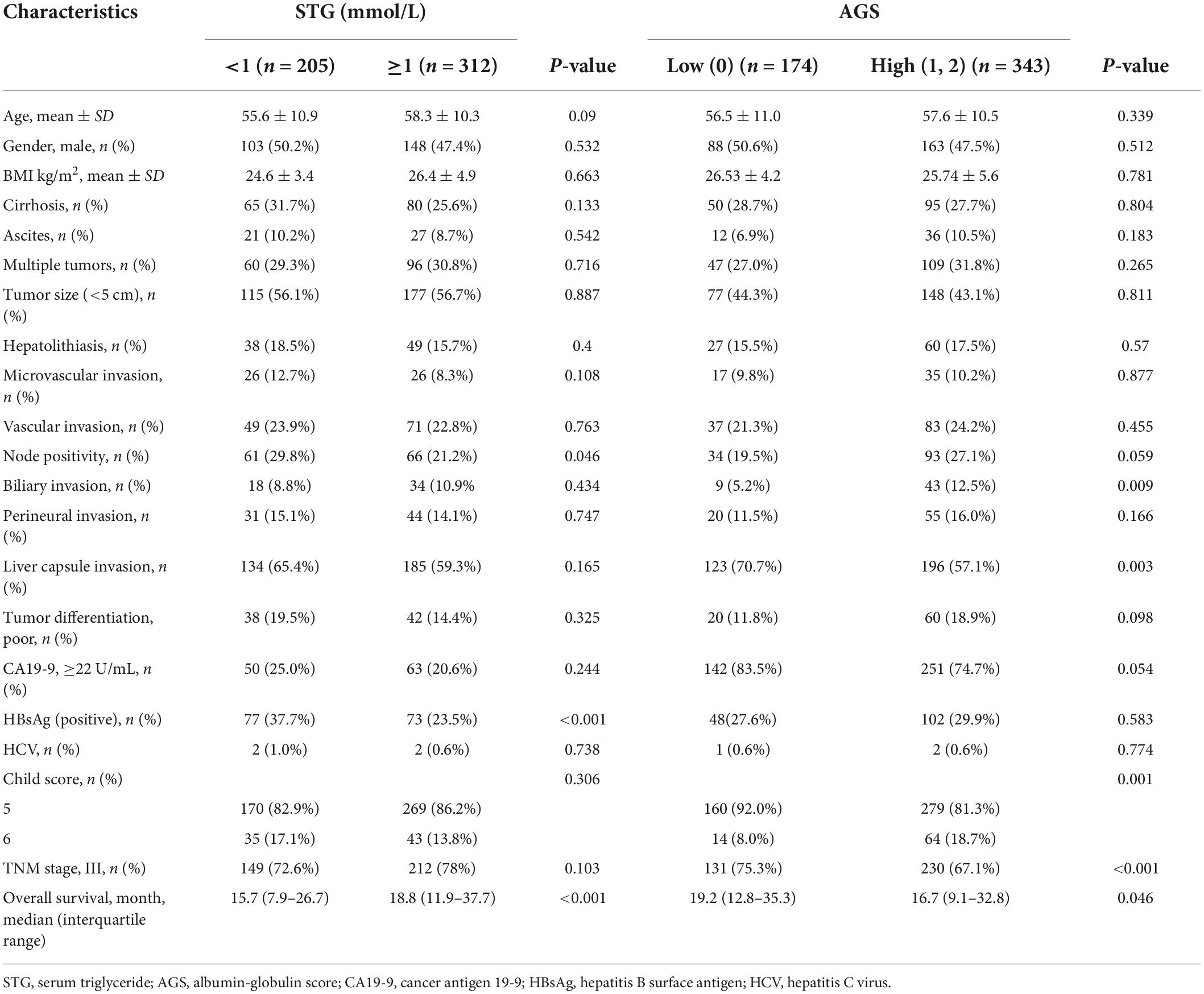
Table 2. Comparison of characteristics with the different serum triglyceride levels and AGS grades of 517 ICC patients treated with surgical resection in the discovery set.
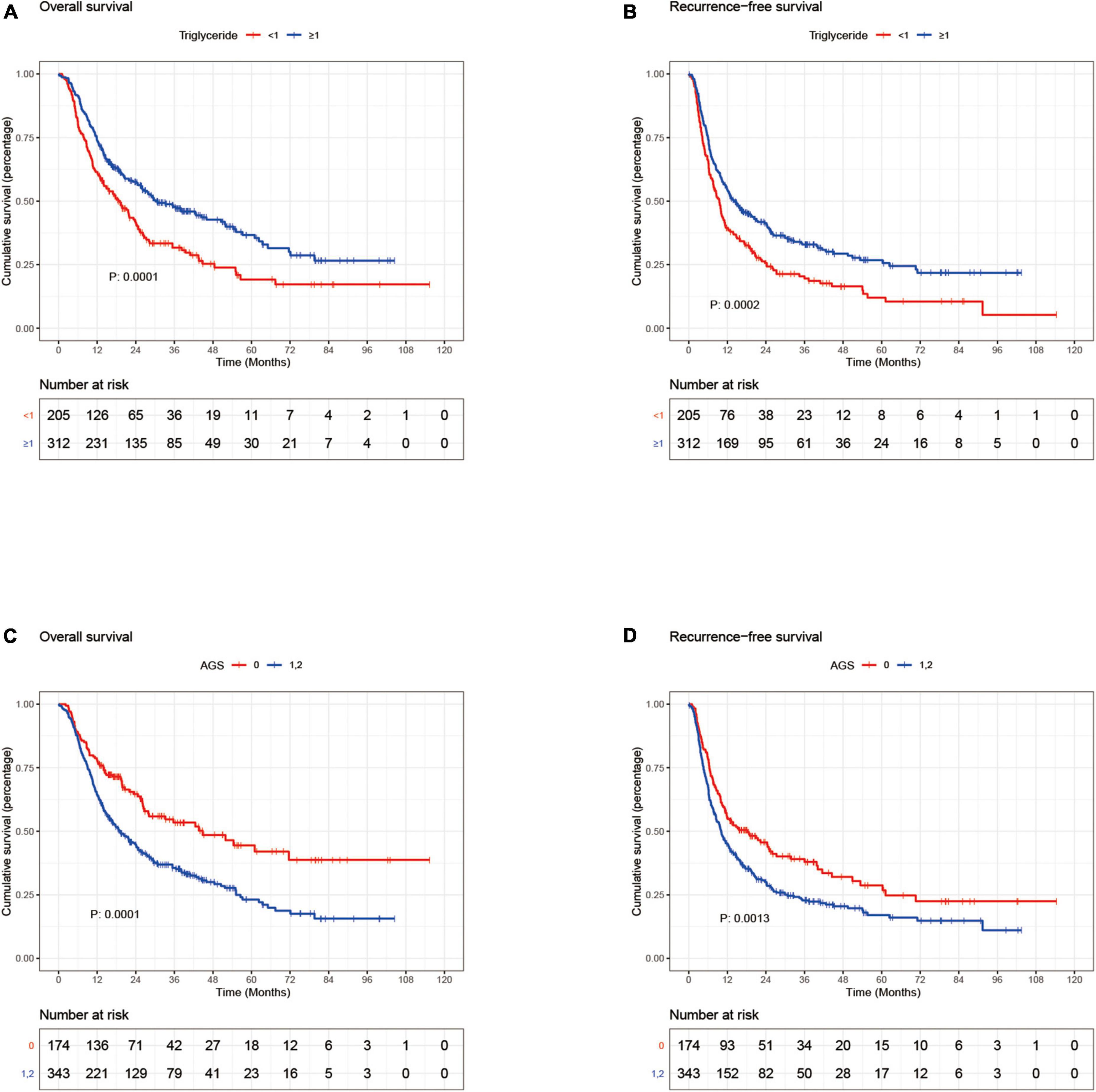
Figure 1. Kaplan–Meier curves for overall survival and recurrence-free survival stratified by triglyceride (A,B) and AGS (C,D) in the discovery set; AGS, albumin-globulin score.
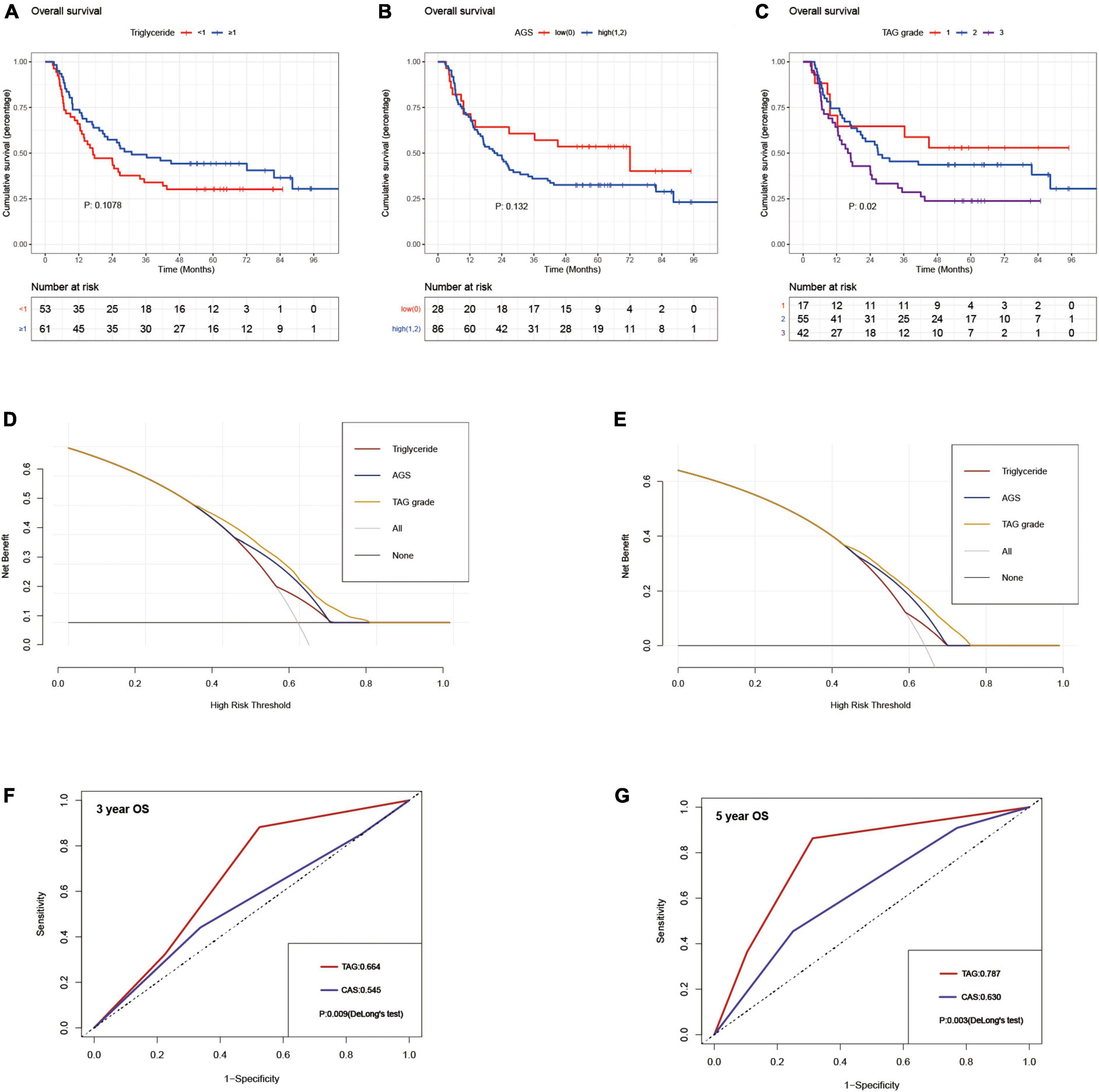
Figure 2. Kaplan–Meier curves for overall survival stratified by triglyceride (A), AGS (B), and TAG grade (C) in the validation set; decision curve analyses for overall survival of triglyceride, AGS and TAG grade in the discovery set (D) and validation set (E); comparison of area under receiver operator characteristic curves for TAG and CAS grade in predicting 3-year (F) and 5-year (G) overall survival in the validation set using DeLong’s test; AGS, albumin-globulin score; TAG grade, triglyceride-albumin-globulin grade; CAS grade, combination of albumin-globulin score and skeletal muscle index.
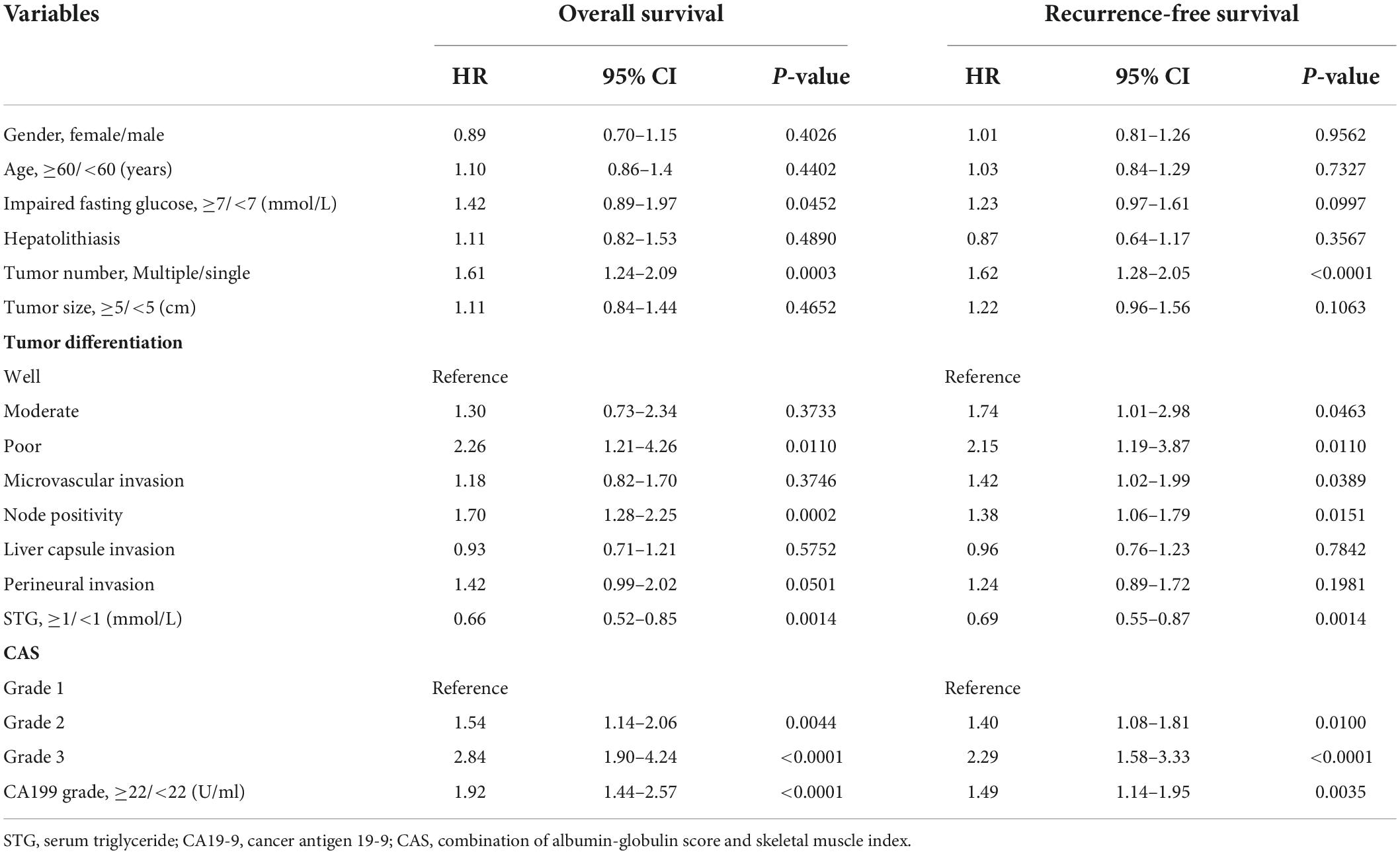
Table 3. Multivariate analyses to determine independent predictors of overall survival and recurrence-free survival in the discovery set.
Albumin-globulin score was associated with prognosis of intrahepatic cholangiocarcinoma patients after curative resection
Intrahepatic cholangiocarcinoma Patients were stratified into two groups according to the AGS; higher AGS stratification (1, 2) was associated with poor OS and RFS than the lower AGS stratification (0) in the discovery set (Figures 1C,D). In the validation set, marginal significance was likewise obtained on the difference between the two groups (P = 0.132) (Figure 2B). The correlations of clinicopathological characteristics with the AGS in the discovery and validation sets were exhibited in Table 2 and Supplementary Table 1.
The proposal and validation of triglyceride-albumin-globulin grade
The triglyceride-albumin-globulin (TAG) grade was proposed as follows: patients with high TG level (≥1 mmol/L) and low AGS (0) were classified into TAG grade 1, those with low TG level (<1 mmol/L) and high AGS (1, 2) were classified into TAG grade 3, the rest of the patients were classified into TAG grade 2. In the discovery set, the patients in TAG grade 2 had superior 1-, 3-, and 5-year cumulative OS and RFS than those in TAG grade 3 (OS: 69.4, 24.1, and 8.6% vs. 57, 17.7, and 3.7%; RFS: 48.9, 16.2, and 6.8% vs. 34.1, 10.4, and 2.2%), but worse than those in TAG grade 1 (OS: 69.4, 24.1, and 8.6% vs. 83.7, 28.8, and 11.5%; RFS: 48.9, 16.2, and 6.8% vs. 60.6, 24, and 9.6%) (Figures 3A,B). A similar result was also generated in the patients of the validation set (Figure 2C). Moreover, the TAG grade possessed stronger predictive ability than the single use of TG or AGS through the result of time-dependent AUC analysis (Figures 3C,D). Subgroup analyses were conducted to further validate the efficacy of TAG grade in multiple clinical conditions, including different gender, age, number and diameter of tumor nodules, tumor differentiation, CA19-9 level and Child score; with or without liver cirrhosis, vascular invasion, positive lymph node, perineural and liver capsule invasion. The results of subgroup analyses shown in Figures 4A,B suggested that the ICC patients in higher TAG grades were related to decreased OS and RFS in various clinical conditions. Survival analyses based on Cox proportional hazard models in the discovery and validation sets presented that the TAG grade remained the independent risk factor for postoperative outcomes of surgically treated ICC patients (Table 4 and Supplementary Table 3). As shown in Figures 2D,E, the TAG grade demonstrated preferable net benefits within a wider range of threshold probability than the single use of either TG or AGS in predicting OS for the patients in both the discovery and validation sets. Moreover, in the validation set, the predicting abilities of the TAG grade were superior to the CAS grade in our previous study (21) (Figures 2F,G). The correlations between clinical characteristics and the TAG grade in the discovery and validation set were presented in Table 5 and Supplementary Table 2.
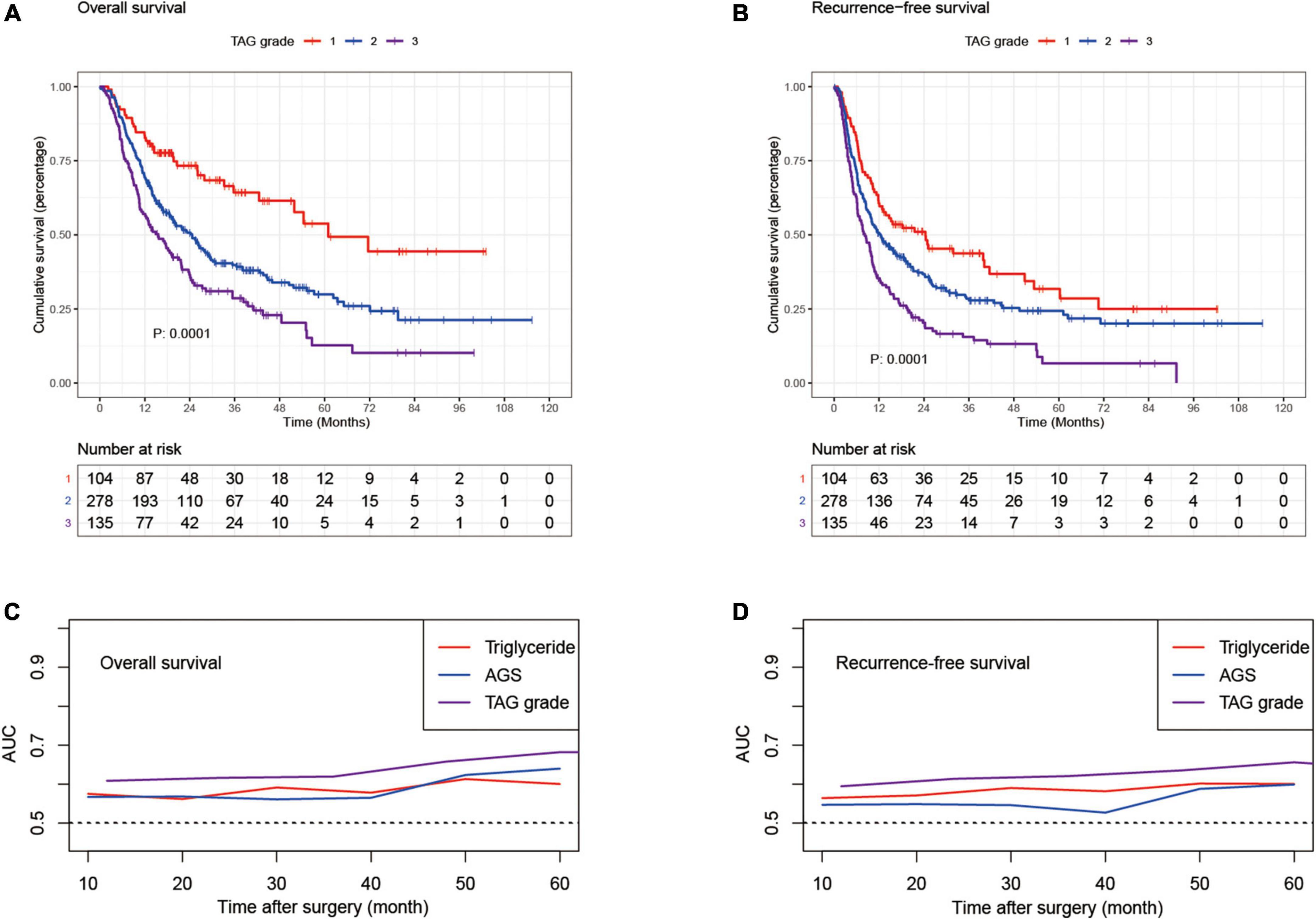
Figure 3. Kaplan–Meier curves for overall survival and recurrence-free survival stratified by TAG grade (A,B) in the discovery set; time-dependent AUROC curves of triglyceride, AGS and TAG grade for overall survival (C) and recurrence-free survival (D) in the discovery set; AUROC, area under receiver operating characteristic; AGS, albumin-globulin score; TAG grade, triglyceride-albumin-globulin grade.
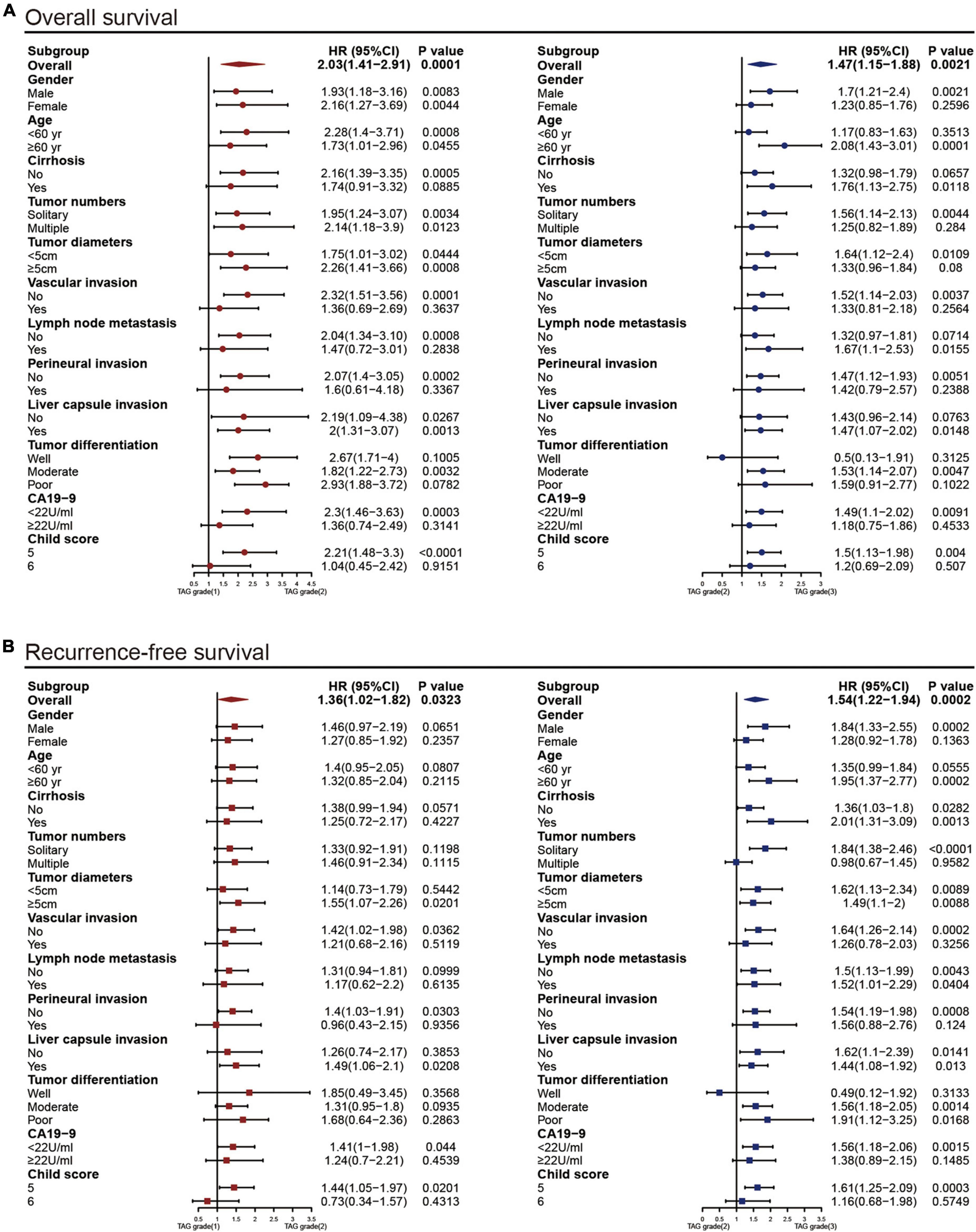
Figure 4. Subgroup analyses to assess the discrimination ability of the TAG grade for overall survival (A) and recurrence-free survival (B) in patients with different clinical characteristics; HR, hazard ratio; CI, confidence interval; TAG grade, triglyceride-albumin-globulin grade.
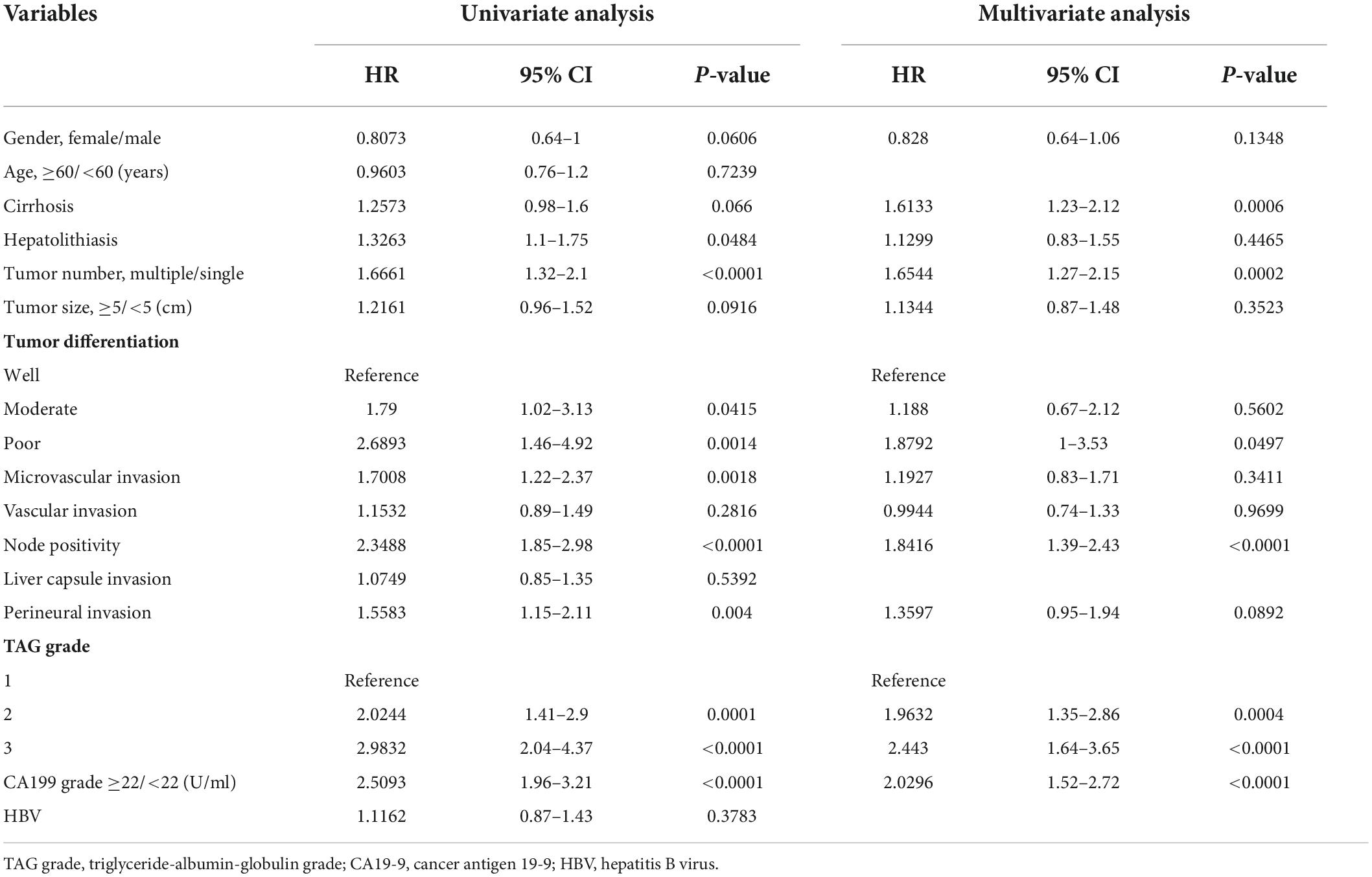
Table 4. Univariate and multivariate analyses to determine independent predictors of overall survival in the discovery set.
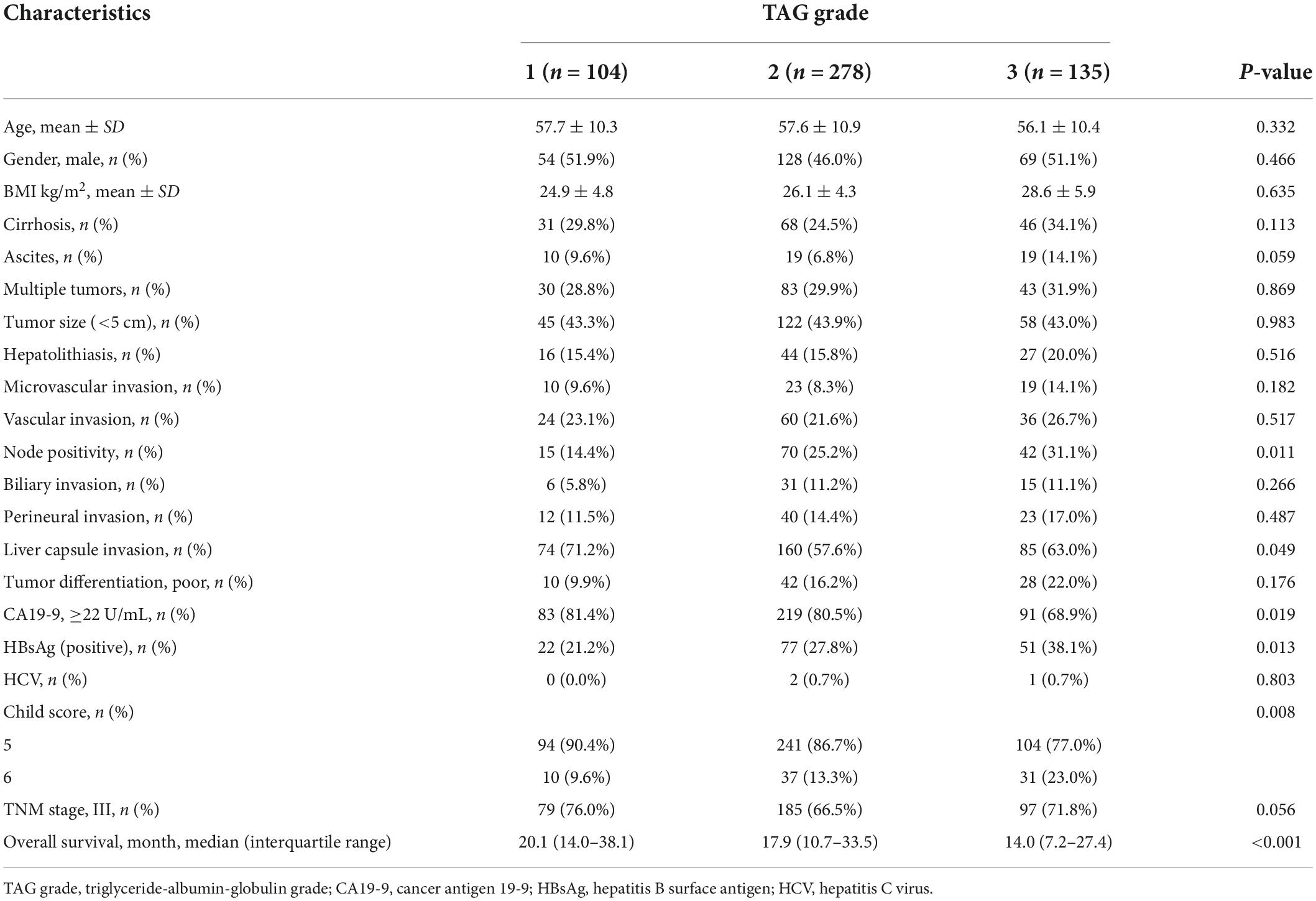
Table 5. Comparison of characteristics with the different TAG grades of 517 ICC patients treated with surgical resection in the discovery set.
Discussion
The present study revealed that elevated preoperative serum TG was an independent protective factor for ICC patients after curative liver resection. TG showed the greatest predictive effectiveness among several parameters related to hepatic function and serum lipid level. Likewise. AGS demonstrated discriminative capability in predicting long-term surgical outcomes of the ICC patients. The serum TG level and AGS were further combined into a novel nutrition grade called TAG grade, the ICC patients in different TAG grades displayed markedly different postoperative survival rates; these differences were maintained in various subgroups as well. Additionally, with superior predictive ability than the TG and AGS, the TAG grade was a desirable model in the prognosis prediction of ICC patients who underwent curative hepatectomy.
There is evolving evidence that preoperative serum markers play essential roles in the prognosis prediction of patients with primary liver cancers. Conventional markers including AFP, PIVKA-II, and carbohydrate antigen 19-9 (CA19-9) have been extensively studied and applied in HCC and ICC patients (26, 27). By combining inflammation-related indexes (counts of lymphocyte, monocyte, neutrophil and platelet; concentration of C-reactive protein) and liver function parameters [levels of bilirubin, albumin, aspartate aminotransferase (AST), alanine aminotransferase (ALT), alkaline phosphatase (ALP), and gamma-glutamyl transpeptidase (GGT)], several prognostic scores including the Glasgow Prognostic Score (GPS), Prognostic Nutritional Index (PNI), and lymphocyte-C-reactive protein ratio (LCR) were introduced and validated in predicting outcomes of ICC patients following surgical treatments (28, 29). Nutritional status has been broadly reported to be implicated in cancer progression and prognosis (30); an effective nutritional assessment before surgery is crucial for achieving optimal short- and long-term survival of ICC patients. In our previous study (21), the SMI generated from the CT was used to evaluate the nutritional status of ICC patients prior to the operation, which exhibited a good clinical efficacy. However, interpretation of the radiographic based SMI required the assistances of the experienced radiologists, which limited its application, especially in primary health-care facilities. therefore, an easy-to-use serological index was needed. Notwithstanding, serological indicators for preoperative evaluation of nutritional status are limited.
TG is the most common type of fat derived from dietary intake or extra calories. The correlation between circulating TG concentration and a range of metabolic diseases including diabetes and CHD has been extensively studied recently (31, 32). In 1991, elevated serum TG level was reported to be associated with a higher incidence of developing breast cancer (33). In the male population, fasting TG and glucose levels were significantly correlated with the risk of non-small-cell lung cancer (34). In a large cohort study involving 1,56,153 participants in Austria, serum TG concentration was found to be positively or reversely associated with multiple malignancies (13). Liu et al. (14) demonstrated that the serum TG level less than 0.81 mmol/L was a predictor for a worse prognosis of HCC patients in the absence of liver cirrhosis. Andreotti et al. (15) reported a positive correlation between STG and biliary malignancies (gall bladder, extrahepatic bile duct and the ampulla of Vater). Interestingly, a robust negative correlation between TG level and poor prognosis of ICC patients following liver resection was discovered in the present study. Apart from conventional risk factors such as primary sclerosing cholangitis, biliary tract cysts and hepatolithiasis for both ECC and ICC; chronic hepatitis, obesity, alcoholic, and non-alcoholic liver diseases are emerging as major concerns in the etiology of ICC (35). These diversities may explain why the increased STG levels were associated with higher prevalence of ECC but better prognosis of ICC.
The mechanism underlying the relationship between TG and liver cancer has not been fully elucidated. Lipid metabolism is emerging as an essential factor in tumor initiation and progression; several targets evolved in lipid metabolism have been reported as potential therapeutic targets in the treatment of primary liver cancer. During the De- novo FA synthesis of liver cancer, glucose is taken up in the HCC cell and converted into FA for storage in the form of TG, which plays crucial roles in cancer cell survival by inducing autophagy, influencing intracellular signaling and gene expression, meanwhile increasing energy production (36). Related targets include SCD1 (37), FASN (38) and ACC (39) and their inhibitors have been intensely investigated in the proliferation and metastasis of liver cancer. Moreover, some of the canonical cancer signal transduction pathways such as AMP-activated protein kinase (AMPK) (40), Wnt and Ras pathways were considered to have an impact on TG composition, thus affecting hepatic tumorigenesis (41).
The ALB is one of the most frequently used markers for evaluating the nutritional statuses of cancer patients (42). Serum ALB may act as a tumor suppressor through the following mechanisms: on the one hand, the activated pro-inflammatory cytokines including IL-6 and TNF-α inhibit the secretion of ALB by hepatic cells, these cytokines are critical molecules driving liver cancer progression (43); on the other hand, ALB serves as a stabilizer of cell growth and DNA replication by scavenging the free radicals, thereby maintains the endocrine homeostasis (44).
Given the prognostic values of TG and AGS in surgically treated ICC patients, a novel nutritional model (TAG grade) was proposed by combining these two markers. The TAG grade exhibited optimal discriminatory capability and reliable clinical efficacy, superior to the CT-based CMI grade in our previous study (21).
This study is noticeable in the following aspects. Firstly, this was the first study to elucidate the correlation between serum TG and prognosis of ICC in a large cohort of 631 patients including multiple medical centers. Secondly, as far as we are aware, this was the first study that combined serum TG, ALB, and GLB levels to assess the long-term survival of ICC patients after curative resection. The results may be profitable for nutritional assessment and patient selection prior to surgical treatment.
Despite the positive outcomes, there were significant restrictions: (1) the two involved centers were situated in the southwest part of mainland China, because of the high frequency of hepatolithiasis in this area, the accuracy of the TAG grade may be restricted by the etiological agents and retrospective design, further prospective worldwide studies were required to confirm our initial findings. (2) A small part of patients underwent retreatment at different medical facilities following tumor recurrence; as a result, this study was unable to examine the impact of postoperative treatment for recurrent ICC, which may affect the outcomes of this part of patients. (3) The glucose level was not assessed as a covariate; given the potential impact that the hyperglycemia had on the TG level, the results might be confounded.
Conclusion
Elevated serum TG concentration was independently associated with better long-term outcomes of ICC patients following curative hepatectomies. It is beneficial to consider the proposed TAG grade as a surrogate nutritional score in risk classification for surgically treated ICC patients.
Data availability statement
The raw data supporting the conclusions of this article will be made available by the authors, without undue reservation, to any qualified researcher.
Ethics statement
Written informed consents were obtained from all participants or their entrusted agents. This study was approved by the Ethics Committee of West China Hospital of Sichuan University and the First Affiliated Hospital of Chongqing Medical University, following the guidelines of the 1975 Declaration of Helsinki.
Author contributions
YC, TL, and HW: conceptualization. YC, JL, HX, and SX: data curation. YC and TL: formal analysis and writing—original draft. HW and TL: supervision. All authors contributed to the article and approved the submitted version.
Funding
This work was supported by grants from the Natural Science Foundation of China (82173124 and 81972747).
Conflict of interest
The authors declare that the research was conducted in the absence of any commercial or financial relationships that could be construed as a potential conflict of interest.
Publisher’s note
All claims expressed in this article are solely those of the authors and do not necessarily represent those of their affiliated organizations, or those of the publisher, the editors and the reviewers. Any product that may be evaluated in this article, or claim that may be made by its manufacturer, is not guaranteed or endorsed by the publisher.
Supplementary material
The Supplementary Material for this article can be found online at: https://www.frontiersin.org/articles/10.3389/fnut.2022.964591/full#supplementary-material
Abbreviations
ACC, acetyl CoA carboxylase; AFP, alpha-fetoprotein; AGS, albumin-globulin score; AJCC, American Joint Committee on Cancer; ALB, albumin; ALBI, albumin-bilirubin index; ALD, alcoholic liver disease; ALP, alkaline phosphatase; ALT, alanine aminotransferase; AMPK, AMP-activated protein kinase; AST, aspartate aminotransferase; AUC, area under curve; BMI, body mass index; CAS, combination of albumin-globulin score and skeletal muscle index; CA19-9, cancer antigen 19-9; CEA, carcinoembryonic antigen; CHD, coronary heart disease; CHOL, cholesterol; CT, computed tomography; DCA, decision curve analysis; DNA, deoxyribonucleic acid; ECC, extrahepatic cholangiocarcinoma; FA, fatty acid; FASN, fatty acid synthase; FIB-4, fibrosis-4 index; GLB, globulin; GPS, glasgow prognostic score; HBV, hepatitis B virus; HCC, hepatocellular carcinoma; HCV, hepatitis C virus; ICC, intrahepatic cholangiocarcinoma; IL-6, interleukin-6; INR, international normalized ratio; LCR, lymphocyte-C-reactive protein ratio; LDL-C, low-density lipoprotein; MVI, microvascular invasion; NAFLD, non-alcoholic fatty liver disease; NLR, neutrophil-to-lymphocyte ratio; OS, overall survival; PIVKA-II, prothrombin induced by vitamin K absence-II; PNI, prognostic nutritional index; RFA, radiofrequency ablation; RFS, recurrence-free survival; ROC, receiver operating characteristic; SCD-1, stearoyl-CoA desaturase-1; SMI, skeletal muscle index; STG, serum triglyceride; TACE, transarterial chemoembolization; TAG grade, triglyceride-albumin-globulin grade; TNF-α, tumor necrosis factor-α; TNM, tumor-node-metastasis.
Footnotes
- ^ http://www.empowerstats.com
- ^ https://www.r-project.org
- ^ http://medicine.yale.edu/lab/rimm/research/software
References
1. Zhou M, Wang H, Zeng X, Yin P, Zhu J, Chen W, et al. Mortality, morbidity, and risk factors in China and its provinces, 1990-2017: a systematic analysis for the Global Burden of Disease Study 2017. Lancet. (2019) 394:1145–58.
2. Cao M, Li H, Sun D, Chen W. Cancer burden of major cancers in China: a need for sustainable actions. Cancer Commun. (2020) 40:205–10. doi: 10.1002/cac2.12025
3. Rizvi S, Gores GJ. Pathogenesis, diagnosis, and management of cholangiocarcinoma. Gastroenterology. (2013) 145:1215–29.
5. Saha SK, Zhu AX, Fuchs CS, Brooks GA. Forty-year trends in cholangiocarcinoma incidence in the U.S.: intrahepatic disease on the rise. Oncologist. (2016) 21:594–9. doi: 10.1634/theoncologist.2015-0446
6. Javle M, Lowery M, Shroff RT, Weiss KH, Springfeld C, Borad MJ, et al. Phase II study of BGJ398 in patients with FGFR-altered advanced cholangiocarcinoma. J Clin Oncol. (2018) 36:276–82.
7. Job S, Rapoud D, Dos Santos A, Gonzalez P, Desterke C, Pascal G, et al. Identification of four immune subtypes characterized by distinct composition and functions of tumor microenvironment in intrahepatic cholangiocarcinoma. Hepatology. (2020) 72:965–81. doi: 10.1002/hep.31092
8. Wang FS, Fan JG, Zhang Z, Gao B, Wang HY. The global burden of liver disease: the major impact of China. Hepatology. (2014) 60:2099–108.
9. Zhou J, Zhou F, Wang W, Zhang XJ, Ji YX, Zhang P, et al. Epidemiological features of NAFLD From 1999 to 2018 in China. Hepatology. (2020) 71:1851–64. doi: 10.1002/hep.31150
10. Zhou F, Zhou J, Wang W, Zhang XJ, Ji YX, Zhang P, et al. Unexpected rapid increase in the burden of NAFLD in China from 2008 to 2018: a systematic review and meta-analysis. Hepatology. (2019) 70:1119–33. doi: 10.1002/hep.30702
11. Welzel TM, Graubard BI, Zeuzem S, El-Serag HB, Davila JA, McGlynn KA. Metabolic syndrome increases the risk of primary liver cancer in the United States: a study in the SEER-Medicare database. Hepatology. (2011) 54:463–71. doi: 10.1002/hep.24397
12. Chaiteerakij R, Yang JD, Harmsen WS, Slettedahl SW, Mettler TA, Fredericksen ZS, et al. Risk factors for intrahepatic cholangiocarcinoma: association between metformin use and reduced cancer risk. Hepatology. (2013) 57:648–55. doi: 10.1002/hep.26092
13. Ulmer H, Borena W, Rapp K, Klenk J, Strasak A, Diem G, et al. Serum triglyceride concentrations and cancer risk in a large cohort study in Austria. Br J Cancer. (2009) 101:1202–6. doi: 10.1038/sj.bjc.6605264
14. Liu X, Li M, Wang X, Dang Z, Jiang Y, Wang X, et al. Effect of serum triglyceride level on the prognosis of patients with hepatocellular carcinoma in the absence of cirrhosis. Lipids Health Dis. (2018) 17:248. doi: 10.1186/s12944-018-0898-y
15. Andreotti G, Chen J, Gao Y-T, Rashid A, Chang S-C, Shen M-C, et al. Serum lipid levels and the risk of biliary tract cancers and biliary stones: a population-based study in China. Int J Cancer. (2008) 122:2322–9.
16. Huang L, Mo Z, Zhang L, Qin S, Qin S, Li S. Diagnostic value of albumin to fibrinogen ratio in cervical cancer. Int J Biol Markers. (2020) 35:66–73.
17. Matsuda S, Takeuchi H, Kawakubo H, Fukuda K, Nakamura R, Takahashi T, et al. Cumulative prognostic scores based on plasma fibrinogen and serum albumin levels in esophageal cancer patients treated with transthoracic esophagectomy: comparison with the Glasgow prognostic score. Ann Surg Oncol. (2015) 22:302–10. doi: 10.1245/s10434-014-3857-5
18. Meyer EJ, Nenke MA, Rankin W, Lewis JG, Torpy DJ. Corticosteroid-binding globulin: a review of basic and clinical advances. Horm Metab Res. (2016) 48:359–71. doi: 10.1055/s-0042-108071
19. Lv GY, An L, Sun XD, Hu YL, Sun DW. Pretreatment albumin to globulin ratio can serve as a prognostic marker in human cancers: a meta-analysis. Clin Chim Acta. (2018) 476:81–91.
20. Li X, Qin S, Sun X, Liu D, Zhang B, Xiao G, et al. Prognostic significance of albumin-globulin score in patients with operable non-small-cell lung cancer. Ann Surg Oncol. (2018) 25:3647–59. doi: 10.1245/s10434-018-6715-z
21. Li H, Dai J, Lan T, Liu H, Wang J, Cai B, et al. Combination of albumin-globulin score and skeletal muscle index predicts long-term outcomes of intrahepatic cholangiocarcinoma patients after curative resection. Clin Nutr. (2021) 40:3891–900. doi: 10.1016/j.clnu.2021.04.038
22. Vallet-Pichard A, Mallet V, Nalpas B, Verkarre V, Nalpas A, Dhalluin-Venier V, et al. FIB-4: an inexpensive and accurate marker of fibrosis in HCV infection. comparison with liver biopsy and fibrotest. Hepatology. (2007) 46:32–6. doi: 10.1002/hep.21669
23. Johnson PJ, Berhane S, Kagebayashi C, Satomura S, Teng M, Reeves HL, et al. Assessment of liver function in patients with hepatocellular carcinoma: a new evidence-based approach-the ALBI grade. J Clin Oncol. (2015) 33:550–8. doi: 10.1200/JCO.2014.57.9151
24. Camp RL, Dolled-Filhart M, Rimm DL. X-tile: a new bio-informatics tool for biomarker assessment and outcome-based cut-point optimization. Clin Cancer Res. (2004) 10:7252–9. doi: 10.1158/1078-0432.CCR-04-0713
25. Chun YS, Pawlik TM, Vauthey JN. 8th edition of the AJCC cancer staging manual: pancreas and hepatobiliary cancers. Ann Surg Oncol. (2018) 25:845–7. doi: 10.1245/s10434-017-6025-x
26. Park H, Kim SU, Park JY, Kim DY, Ahn SH, Chon CY, et al. Clinical usefulness of double biomarkers AFP and PIVKA-II for subdividing prognostic groups in locally advanced hepatocellular carcinoma. Liver Int. (2014) 34:313–21. doi: 10.1111/liv.12274
27. Feng F, Gao Q, Wu Y, Liu C, Yu Y, Li B, et al. Cytoreductive surgery combined with hyperthermic intraperitoneal chemotherapy vs. cytoreductive surgery alone for intrahepatic cholangiocarcinoma with peritoneal metastases: a retrospective cohort study. Eur J Surg Oncol. (2021) 47:2363–8. doi: 10.1016/j.ejso.2021.05.014
28. Lin J, Fang T, Zhu M, Xu X, Zhang J, Zheng S, et al. Comparative performance of inflammation-based prognostic scores in patients operated for intrahepatic cholangiocarcinoma. Cancer Manag Res. (2019) 11:9107–19.
29. Lu LH, Zhong C, Wei W, Li SH, Mei J, Zou JW, et al. Lymphocyte-C-reactive protein ratio as a novel prognostic index in intrahepatic cholangiocarcinoma: a multicentre cohort study. Liver Int. (2021) 41:378–87. doi: 10.1111/liv.14567
30. Arends J, Baracos V, Bertz H, Bozzetti F, Calder PC, Deutz NEP, et al. ESPEN expert group recommendations for action against cancer-related malnutrition. Clin Nutr. (2017) 36:1187–96. doi: 10.1016/j.clnu.2017.06.017
31. Sarwar N, Sandhu MS, Ricketts SL, Butterworth AS, Di Angelantonio E, Boekholdt SM, et al. Triglyceride-mediated pathways and coronary disease: collaborative analysis of 101 studies. Lancet. (2010) 375:1634–9. doi: 10.1016/S0140-6736(10)60545-4
32. Pirillo A, Casula M, Olmastroni E, Norata GD, Catapano AL. Global epidemiology of dyslipidaemias. Nat Rev Cardiol. (2021) 18:689–700.
33. Potischman N, McCulloch CE, Byers T, Houghton L, Nemoto T, Graham S, et al. Associations between breast cancer, plasma triglycerides, and cholesterol. Nutr Cancer. (1991) 15:205–15.
34. Yan X, Gao Y, Tong J, Tian M, Dai J, Zhuang Y. Association between triglyceride glucose index and non-small cell lung cancer risk in Chinese population. Front Oncol. (2021) 11:585388. doi: 10.3389/fonc.2021.585388
35. Khan SA, Thomas HC, Davidson BR, Taylor-Robinson SD. Cholangiocarcinoma. Lancet. (2005) 366:1303–14.
36. Pope ED III, Kimbrough EO, Vemireddy LP, Surapaneni PK, Copland JA III, Mody K. Aberrant lipid metabolism as a therapeutic target in liver cancer. Expert Opin Ther Targets. (2019) 23:473–83.
37. Igal RA. Stearoyl-CoA desaturase-1: a novel key player in the mechanisms of cell proliferation, programmed cell death and transformation to cancer. Carcinogenesis. (2010) 31:1509–15. doi: 10.1093/carcin/bgq131
38. Buckley D, Duke G, Heuer TS, O’Farrell M, Wagman AS, McCulloch W, et al. Fatty acid synthase - Modern tumor cell biology insights into a classical oncology target. Pharmacol Ther. (2017) 177:23–31. doi: 10.1016/j.pharmthera.2017.02.021
40. Muoio DM, Seefeld K, Witters LA, Coleman RA. AMP-activated kinase reciprocally regulates triacylglycerol synthesis and fatty acid oxidation in liver and muscle: evidence that sn-glycerol-3-phosphate acyltransferase is a novel target. Biochem J. (1999) 338(Pt. 3):783–91.
41. Yao Y, Sun S, Wang J, Fei F, Dong Z, Ke AW, et al. Canonical Wnt signaling remodels lipid metabolism in zebrafish hepatocytes following ras oncogenic insult. Cancer Res. (2018) 78:5548–60. doi: 10.1158/0008-5472.CAN-17-3964
42. McMillan DC, Watson WS, O’Gorman P, Preston T, Scott HR, McArdle CS. Albumin concentrations are primarily determined by the body cell mass and the systemic inflammatory response in cancer patients with weight loss. Nutr Cancer. (2001) 39:210–3. doi: 10.1207/S15327914nc392_8
43. Chojkier M. Inhibition of albumin synthesis in chronic diseases: molecular mechanisms. J Clin Gastroenterol. (2005) 39(4 Suppl. 2):S143–6.
Keywords: serum triglyceride, intrahepatic cholangiocarcinoma, albumin, globulin, nutritional score
Citation: Cai Y, Xue S, Li J, Xiao H, Lan T and Wu H (2022) A novel nutritional score based on serum triglyceride and protein levels predicts outcomes of intrahepatic cholangiocarcinoma after curative hepatectomy: A multi-center study of 631 patients. Front. Nutr. 9:964591. doi: 10.3389/fnut.2022.964591
Received: 08 June 2022; Accepted: 29 August 2022;
Published: 21 September 2022.
Edited by:
Kalliopi-Anna Poulia, Agricultural University of Athens, GreeceReviewed by:
Shuji Isaji, Mie University Hospital, JapanMarwa El-Zeftawy, New Valley University, Egypt
Copyright © 2022 Cai, Xue, Li, Xiao, Lan and Wu. This is an open-access article distributed under the terms of the Creative Commons Attribution License (CC BY). The use, distribution or reproduction in other forums is permitted, provided the original author(s) and the copyright owner(s) are credited and that the original publication in this journal is cited, in accordance with accepted academic practice. No use, distribution or reproduction is permitted which does not comply with these terms.
*Correspondence: Hong Wu, d3Vob25nQHNjdS5lZHUuY24=; Tian Lan, Ymx1ZV9za3lfbGFuZEAxNjMuY29t
 Yunshi Cai
Yunshi Cai Shuai Xue
Shuai Xue Jiaxin Li
Jiaxin Li Heng Xiao
Heng Xiao Tian Lan1*
Tian Lan1* Hong Wu
Hong Wu